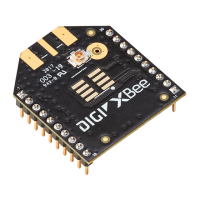Sleep modes About sleep modes
Digi XBee® 3 Cellular LTE Cat 1 AT&T Smart Modem User Guide
143
About sleep modes
A number of low-power modes exist to enable devices to operate for extended periods of time on
battery power. Use SM (Sleep Mode) to enable these sleep modes.
Normal mode
Set SM to 0 to enter Normal mode.
Normal mode is the default sleep mode. If a device is in this mode, it does not sleep and is always
awake.
Devices in Normal mode are typically mains powered.
Pin sleep mode
Set SM to 1 to enter pin sleep mode.
Pin sleep allows the device to sleep and wake according to the state of the SLEEP_RQ pin (SLEEP_RQ).
When you assert SLEEP_RQ (high), the device finishes any transmit or receive operations, closes any
active connection, and enters a low-power state.
When you de-assert SLEEP_RQ (low), the device wakes from pin sleep.
Cyclic sleep mode
Set SM to 4 to enter Cyclic sleep mode.
Cyclic sleep allows the device to sleep for a specific time and wake for a short time to poll.
If you use the D7 command to enable hardware flow control, the CTS pin asserts (low) when the
device wakes and can receive serial data, and de-asserts (high) when the device sleeps.
Cyclic sleep with pin wake up mode
Set SM to 5 to enter Cyclic sleep with pin wake up mode.
This mode is a slight variation on Cyclic sleep mode (SM = 4) that allows you to wake a device
prematurely by de-asserting the SLEEP_RQ pin (SLEEP_RQ).
In this mode, you can wake the device after the sleep period expires, or if a high-to-low transition
occurs on the SLEEP_RQ pin.
The sleep timer
The sleep timer starts when the device wakes and resets on re-configuration. When the sleep timer
expires the device returns to sleep.
MicroPython sleep behavior
When the XBee Smart Modem enters Deep Sleep mode, any MicroPython code currently executing is
suspended until the device comes out of sleep. When the XBee Smart Modem comes out of sleep
mode, MicroPython execution continues where it left off.
Upon entering deep sleep mode, the XBee Smart Modem closes any active UDP connections and turns
off the cellular component. As a result, any sockets that were opened in MicroPython prior to sleep

